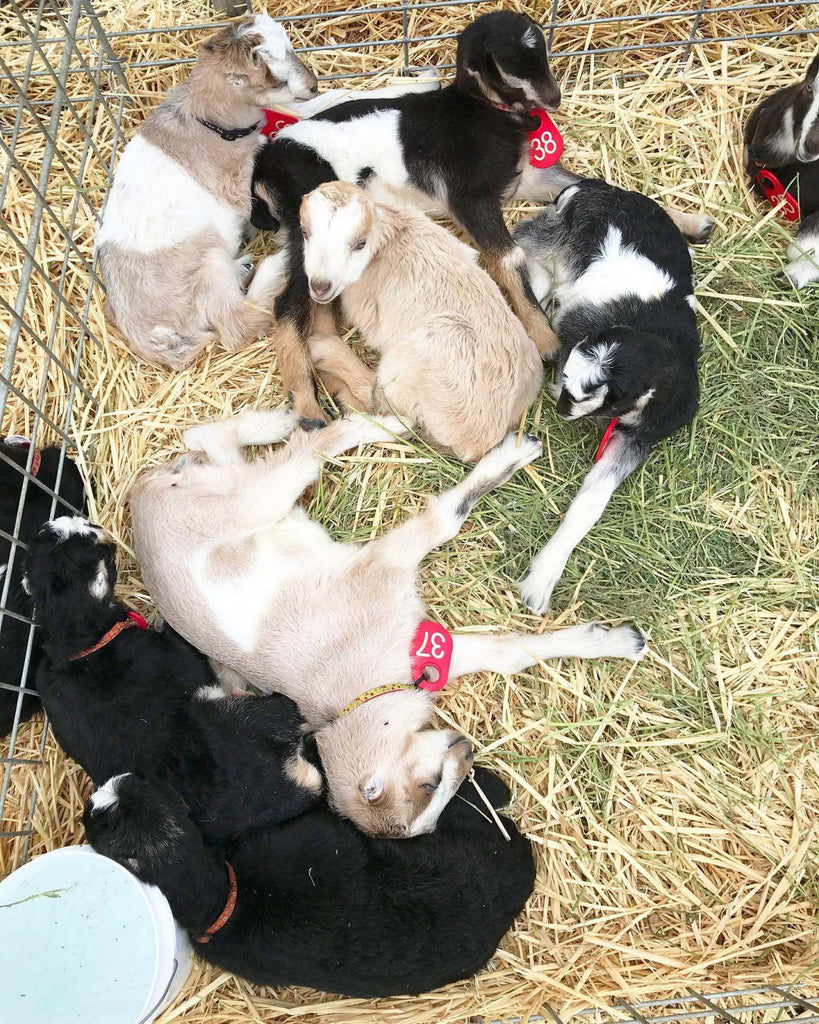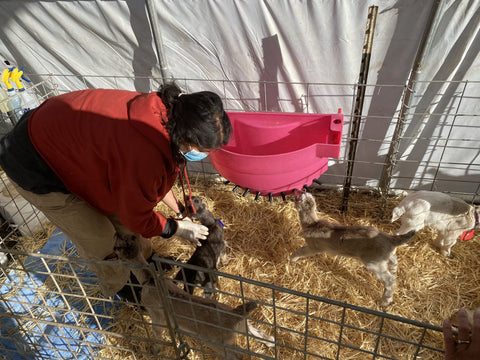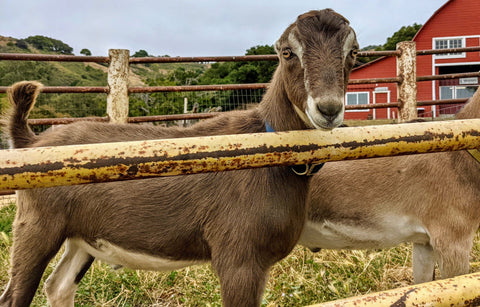Here we are in June and we find ourselves with yet another huge milestone down in the Stepladder calendar that runs our year - we are already all done with baby goat bottle-feeding!
Now that our babies are all done slurping down that delicious goat’s milk, we have moved on to full-time milking and goat cheese production! The three months that passed between the start of birthing season in late February and end of bottle-feeding season at the end of May have gone by in a blur, and now we find ourselves able to take a deep breath as we look back on triumphs of the season.
Here is a quick recap on the bottle-feeding extravaganza, including some answers to frequently asked questions that we get from our customers.

(These hungry little tykes eat their fill of delicious fresh goat’s milk)
The daily ritual of bottle-feeding is an arduous, yet rewarding process. With over 100 kids to feed, the task generally takes several hours out of each day. It starts early in the morning, when the person on bottle feeding duty measures and begins heating the milk in a hot water bath. Once the milk is heated to the right temperature, we bring it out in 5 gallon buckets and begin dolling it out to the hungry Stepladder youth!
We usually keep the kids in groups of ten in their outdoor pens. Rather than feeding each kid individually, we use a contraption that can hold several gallons of milk at a time for feeding these larger groups. It has ten nipples arranged around the outside for quick feeding and is usually called a milk bar or feeding bucket, though we affectionately call it the “mega-boob!” Once we measure out the amount of milk necessary for each group of babies, we pour it into the feeder, latch it onto the side of the pen, and watch the little kids guzzle down the delicious milk as their tails wag in excitement!

(Stepladder Creamery co-owner Jack Rudolph bottle-feeding one of the kids)
Do we bottle-feed directly following birth?
No, we leave the babies with their moms for the first 3-5 days. For the first 48-72 hours immediately following birth, the mamma goats produce Colostrum - a thick, yellowish milk that is loaded with additional fat, probiotics, and antibodies that all help to give the kids an extra boost to their guts and immune systems on those first essential days of life.
Because this colostrum is incredibly essential to the future health of the kids and it is necessary for the kids to eat as often as possible during these first few days, we keep the babies with their dams for those first few days of life. After those first days have passed and the kids are strong and eating large amounts on their own, their dam rejoins the herd and the milking line and we take over the task of bottle-feeding their kids.

Why do we choose to bottle-feed the kids born at Stepladder Ranch rather than leaving them with their moms to be “dam raised”?
Well, we actually did not bottle feed the kids for the first couple of years after the creamery was first founded, but we have discovered over the years that bottle feeding has quite a few benefits when compared to leaving the kids with their mom. For one thing, it guarantees that each kid will have the right amount of milk for their optimum health. Moms with too many or too few kids to feed can end up under or over-producing milk, which can lead to the kids either getting too much or too little milk.
Both of these scenarios can be very bad for the developing kids. Fortunately, bottle-feeding allows us to guarantee that each kid is getting an equal share of the milk supply. Bottle-feeding also contributes to the overall health of the does, as their udders are completely emptied of milk and left unmarred by the kids’ mouth as their teeth and appetites start to grow. And lastly, we have found that bottle feeding generally leads to the kids being more friendly and familiar with humans.
This is helpful when it comes time to train the goats for regular handling and milking, as they already trust us. It also means we can more easily find these little guys wonderful homes as beloved pets if they aren’t going to be kept for milking!

Do the moms and babies miss or look for each other?
Yes and no; we generally find that the moms are more likely to seek out their babies than the reverse, and it seems to depend most on each animal's individual temperament. While some moms re-enter the herd without a second thought for their kids, some of the more devoted mothers might look or call for their babies for the first few hours. Generally the moms move on once they are getting regularly milked and aren’t looking for a little one to empty of an udder full of milk. Also, as long as the weather is decent and can support the frail bodies of the young ones, they are moved outside near the mom’s pen where their dams can see, hear, and smell them. This also seems to help put the mothers at ease.
On the other hand, and perhaps because the kids are still so young, they don’t tend to call or look for their moms. Part of this is probably due to the fact that they are kept in the pen with their siblings and a few other young kids, so they still get all the constant comfort and nurturing of other warm bodies. They are also fed regularly by their human surrogates, so they don’t really have a reason to pine for their moms since they aren’t hungry.

(A group of our overly friendly bottle fed youngsters harassing Whitney, one of their doting caretakers)
However, the hardest part about this transition for the kids is to learn to eat from a bottle rather than their mom’s udder. Some take to it fluidly, while others may take one or two days to really figure it out. Therefore, on these first few days of learning how to eat from a bottle, we allot an extra amount of time in the bottle feeder’s schedule to allow time to patiently teach the kids how to suckle from the artificial nipple and guarantee that each kid is getting a sufficient amount of milk.
Once they are all trained up on drinking from a bottle, they will graduate to the communal bucket feeder that allows us to feed them in larger groups.

(The kids snuggling up for a much needed nap between playtime and feeding)
Do the babies get their own mom’s milk?
No - we actually milk all the does into one large tank where the milk is combined. This ensures that there is enough milk to go around, since some of the moms produce more than their babies can consume and some don't produce enough.
Over the last two years we have also started to pasteurize the milk supply for the little ones. This ensures that there is as little bacteria in the milk as possible, but it also removes all the good probiotics and vitamins.
Therefore, we add back in vitamins such as Vitamin B and C as well as natural powdered herbs to boost their immune system, digestion and overall health. Most of the herbs come from our friends at Fir Meadow and all the goats love them!

(Stepladder staff teaching the new kids on the block how to eat from a bottle)
During the first few months of the birthing season, the majority of the milk goes straight back to the little ones. Luckily our Lamanchas are bred for milking and therefore produce much more milk than their kids can eat, so some of the milk is able to be used for cheesemaking even early in the year.
As the kids grow and begin to be weaned at about 2 months of age, we are able to use larger quantities of milk for cheesemaking. The kids are slowly transitioned to eating more solid food as the milk in their diet is replaced by high protein hay and grain. Once all the kids are fully weaned, all of the more than 63 gallons per day that our does produce daily goes straight into the creamery to make our delicious goat cheeses! Yum!




